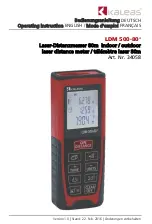
UVX Radiometer
12
If the voltmeter indicates correctly according to the above requirements and the decimal point
fails to come on, then the integrated circuit A2 is malfunctioning and must be replaced. If the
voltmeter does not indicate as described above, then the malfunction is in the range selector
switch and the UVX must be returned to UVP.
•
Display does not turn on.
If the display fails to turn on immediately check the lead wires from the battery to make sure they
are not broken, also check the battery for an output of at least 7.0 volts. Also check the snaps on
the battery connectors. Be sure the snap fingers are pinched together for good contact when
snapped onto the battery terminals. If all these check out correctly, then integrated circuit A4 is
malfunctioning and must be replaced.
•
Test mode does not operate.
Turn the unit on and momentarily connect a jumper between the plus side of the power supply
and pin 2 of integrated circuit A2. NOTE: Do not leave the jumper connected longer than a few
seconds. To do so may cause permanent damage to the Liquid Crystal Display.
During that time the test mode condition should be displayed on the readout. If the display shows
the test mode correctly, then the malfunction is in the ON/TEST switch and the unit must be
returned to UVP for repair. If it is not, then integrated circuit A2 is malfunctioning and must be
replaced.
•
Hold mode does not operate.
Turn the unit on and connect the DC voltmeter between the negative side of the battery and pin 1
of integrated circuit A4. Switch from READ to HOLD. The voltmeter should indicate the battery
voltage while the switch is in the HOLD position.
If the voltmeter indicates the battery voltage, and the display does not remain steady, then the
malfunction is in the integrated circuit A4 and it must be replaced. If the voltmeter does not
indicate the battery voltage, then the malfunction is in the switch and the unit must be returned to
UVP for repair.
•
No display change with UV intensity changes.
Disconnect the sensor from the sensor input jack. Connect a 500K resistor between pin 2 of
integrated circuit A1 and the junction between resistors R1and R3. Connect a variable source
between pin 3 (-) and 2 (+) of integrated circuit A1. Set the current source for an output of .00500
micro amps.
Turn the unit on and set the range switch to the 200 uW/cm2 position.
Connect the negative side of a DC digital voltmeter to pin 3 of integrated circuit A1 and the
positive side to pin 6. Turn the unit on.
For normal operation, the display should read 100.0 uW/cm
2
and the voltmeter should read 1.00
volts. If the display is not indicating correctly or not at all and the voltmeter is indicating 1.00 volts,
then integrated circuit A4 is malfunctioning and must be replaced.
If the voltmeter is not indicating 1.00 Volts, then the input amplifier A1 is malfunctioning and must
be replaced.
Change the range switch to the 2000 uW/cm
2
position. The voltmeter indication should be 0.100
volts and the display should read 100 uW/cm
2
.lf the voltmeter did not change from 1.00 volts,
down to 0.100 volts, then the malfunction is in the range changing switch and the unit must be
returned to UVP for repair.
Change the range switch to the 20 uW/cm
2
position. The display should now indicate 0.10
Summary of Contents for UVX
Page 4: ...UVX Radiometer 4 Figure 1 Rear and Side Views of Radiometer ...
Page 15: ...UVX Radiometer 15 Figure 4 Calibration Current Source Figure 5 LCD Display Pin outs ...
Page 22: ...UVX Radiometer 22 Figure 13 Typical Output From Low Pressure Mercury Lamp ...
Page 29: ...UVX Radiometer 29 Figure 19 Cosine Response of Typical UVX Sensor Polar Plot ...













































